Brand Management Individual Assignment: PAUL in South Africa
VerifiedAdded on 2021/01/11
|11
|2203
|54
Project
AI Summary
This assignment analyzes the brand management strategies of PAUL, a French bakery and restaurant chain, as it enters the South African market. It begins by identifying challenges such as the economic downturn, high failure rates in the food service industry, and expensive data costs, while also highlighting opportunities like a growing tourist market and a favorable investment climate due to a weak rand. The assignment then critiques PAUL's current integrated marketing communication (IMC) efforts, evaluating them based on Keller's criteria, and proposes an IMC program based on the Brand Resonance Model to enhance market growth. This includes strategies for building brand salience, meaning, response, and resonance. Finally, the assignment assesses PAUL's use of secondary brand associations, employing Keller's Awareness, Meaningfulness, and Transferability model. The analysis provides recommendations for improving PAUL's brand positioning and marketing effectiveness in South Africa.
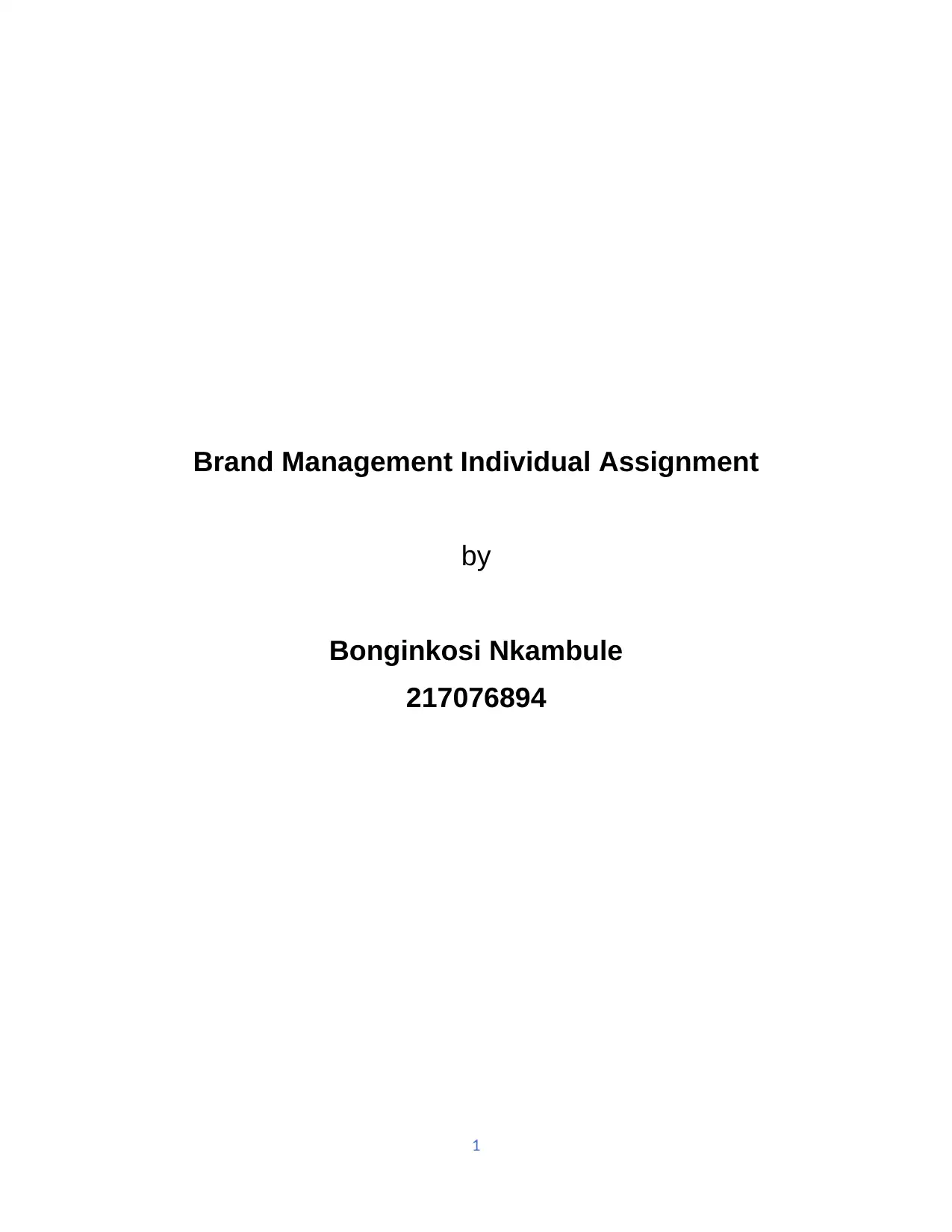
Brand Management Individual Assignment
by
Bonginkosi Nkambule
217076894
1
by
Bonginkosi Nkambule
217076894
1
Paraphrase This Document
Need a fresh take? Get an instant paraphrase of this document with our AI Paraphraser
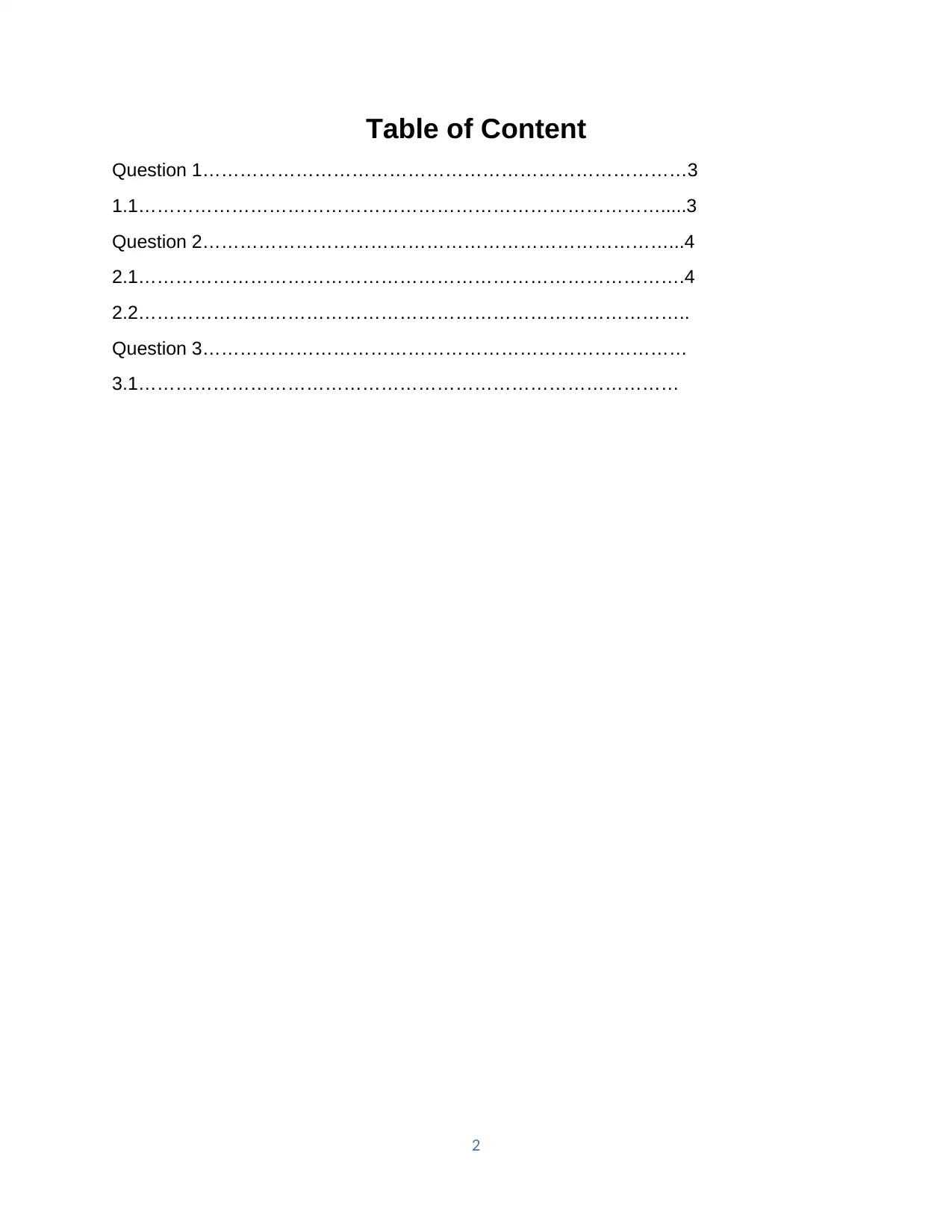
Table of Content
Question 1……………………………………………………………………3
1.1………………………………………………………………………….....3
Question 2…………………………………………………………………...4
2.1…………………………………………………………………………….4
2.2……………………………………………………………………………..
Question 3……………………………………………………………………
3.1……………………………………………………………………………
2
Question 1……………………………………………………………………3
1.1………………………………………………………………………….....3
Question 2…………………………………………………………………...4
2.1…………………………………………………………………………….4
2.2……………………………………………………………………………..
Question 3……………………………………………………………………
3.1……………………………………………………………………………
2
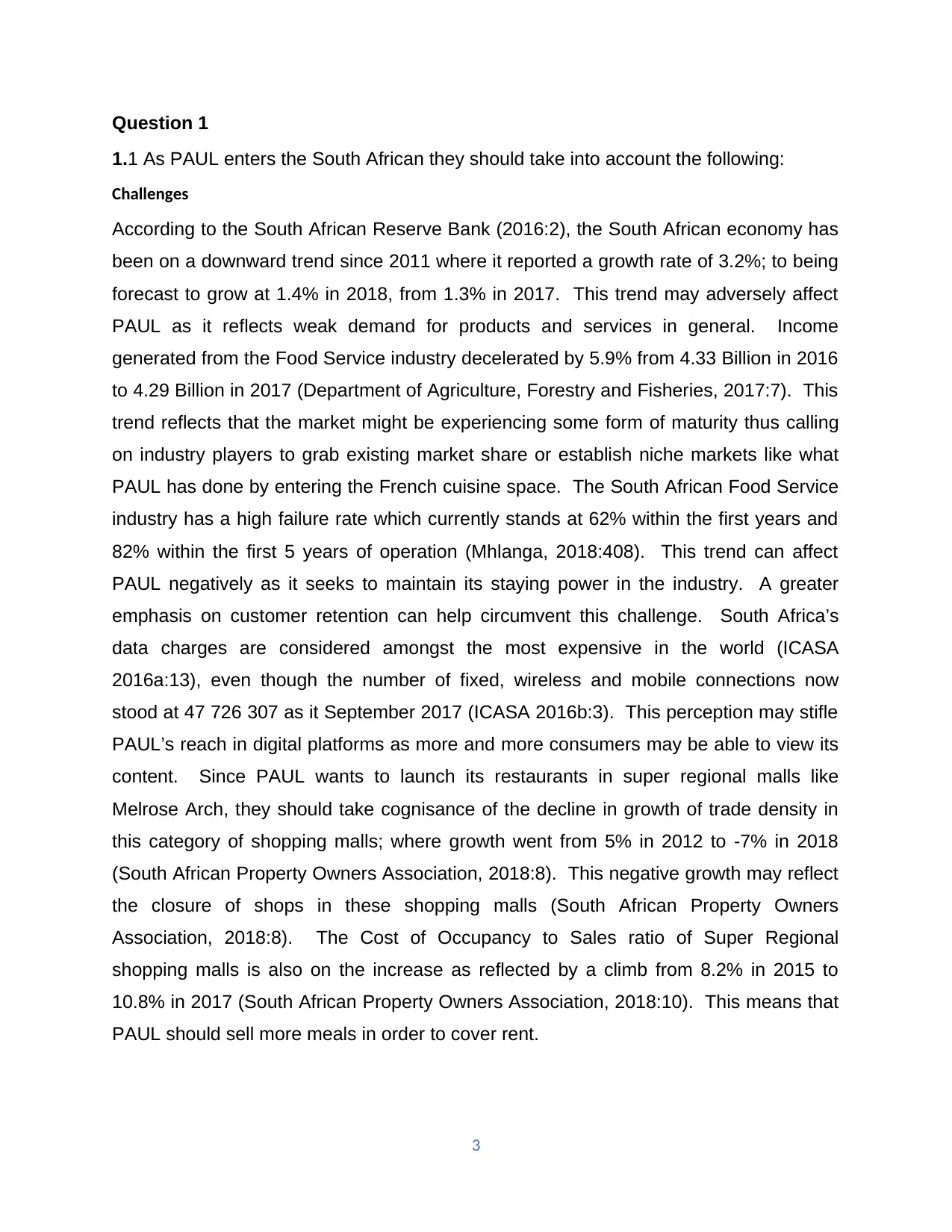
Question 1
1.1 As PAUL enters the South African they should take into account the following:
Challenges
According to the South African Reserve Bank (2016:2), the South African economy has
been on a downward trend since 2011 where it reported a growth rate of 3.2%; to being
forecast to grow at 1.4% in 2018, from 1.3% in 2017. This trend may adversely affect
PAUL as it reflects weak demand for products and services in general. Income
generated from the Food Service industry decelerated by 5.9% from 4.33 Billion in 2016
to 4.29 Billion in 2017 (Department of Agriculture, Forestry and Fisheries, 2017:7). This
trend reflects that the market might be experiencing some form of maturity thus calling
on industry players to grab existing market share or establish niche markets like what
PAUL has done by entering the French cuisine space. The South African Food Service
industry has a high failure rate which currently stands at 62% within the first years and
82% within the first 5 years of operation (Mhlanga, 2018:408). This trend can affect
PAUL negatively as it seeks to maintain its staying power in the industry. A greater
emphasis on customer retention can help circumvent this challenge. South Africa’s
data charges are considered amongst the most expensive in the world (ICASA
2016a:13), even though the number of fixed, wireless and mobile connections now
stood at 47 726 307 as it September 2017 (ICASA 2016b:3). This perception may stifle
PAUL’s reach in digital platforms as more and more consumers may be able to view its
content. Since PAUL wants to launch its restaurants in super regional malls like
Melrose Arch, they should take cognisance of the decline in growth of trade density in
this category of shopping malls; where growth went from 5% in 2012 to -7% in 2018
(South African Property Owners Association, 2018:8). This negative growth may reflect
the closure of shops in these shopping malls (South African Property Owners
Association, 2018:8). The Cost of Occupancy to Sales ratio of Super Regional
shopping malls is also on the increase as reflected by a climb from 8.2% in 2015 to
10.8% in 2017 (South African Property Owners Association, 2018:10). This means that
PAUL should sell more meals in order to cover rent.
3
1.1 As PAUL enters the South African they should take into account the following:
Challenges
According to the South African Reserve Bank (2016:2), the South African economy has
been on a downward trend since 2011 where it reported a growth rate of 3.2%; to being
forecast to grow at 1.4% in 2018, from 1.3% in 2017. This trend may adversely affect
PAUL as it reflects weak demand for products and services in general. Income
generated from the Food Service industry decelerated by 5.9% from 4.33 Billion in 2016
to 4.29 Billion in 2017 (Department of Agriculture, Forestry and Fisheries, 2017:7). This
trend reflects that the market might be experiencing some form of maturity thus calling
on industry players to grab existing market share or establish niche markets like what
PAUL has done by entering the French cuisine space. The South African Food Service
industry has a high failure rate which currently stands at 62% within the first years and
82% within the first 5 years of operation (Mhlanga, 2018:408). This trend can affect
PAUL negatively as it seeks to maintain its staying power in the industry. A greater
emphasis on customer retention can help circumvent this challenge. South Africa’s
data charges are considered amongst the most expensive in the world (ICASA
2016a:13), even though the number of fixed, wireless and mobile connections now
stood at 47 726 307 as it September 2017 (ICASA 2016b:3). This perception may stifle
PAUL’s reach in digital platforms as more and more consumers may be able to view its
content. Since PAUL wants to launch its restaurants in super regional malls like
Melrose Arch, they should take cognisance of the decline in growth of trade density in
this category of shopping malls; where growth went from 5% in 2012 to -7% in 2018
(South African Property Owners Association, 2018:8). This negative growth may reflect
the closure of shops in these shopping malls (South African Property Owners
Association, 2018:8). The Cost of Occupancy to Sales ratio of Super Regional
shopping malls is also on the increase as reflected by a climb from 8.2% in 2015 to
10.8% in 2017 (South African Property Owners Association, 2018:10). This means that
PAUL should sell more meals in order to cover rent.
3
⊘ This is a preview!⊘
Do you want full access?
Subscribe today to unlock all pages.

Trusted by 1+ million students worldwide
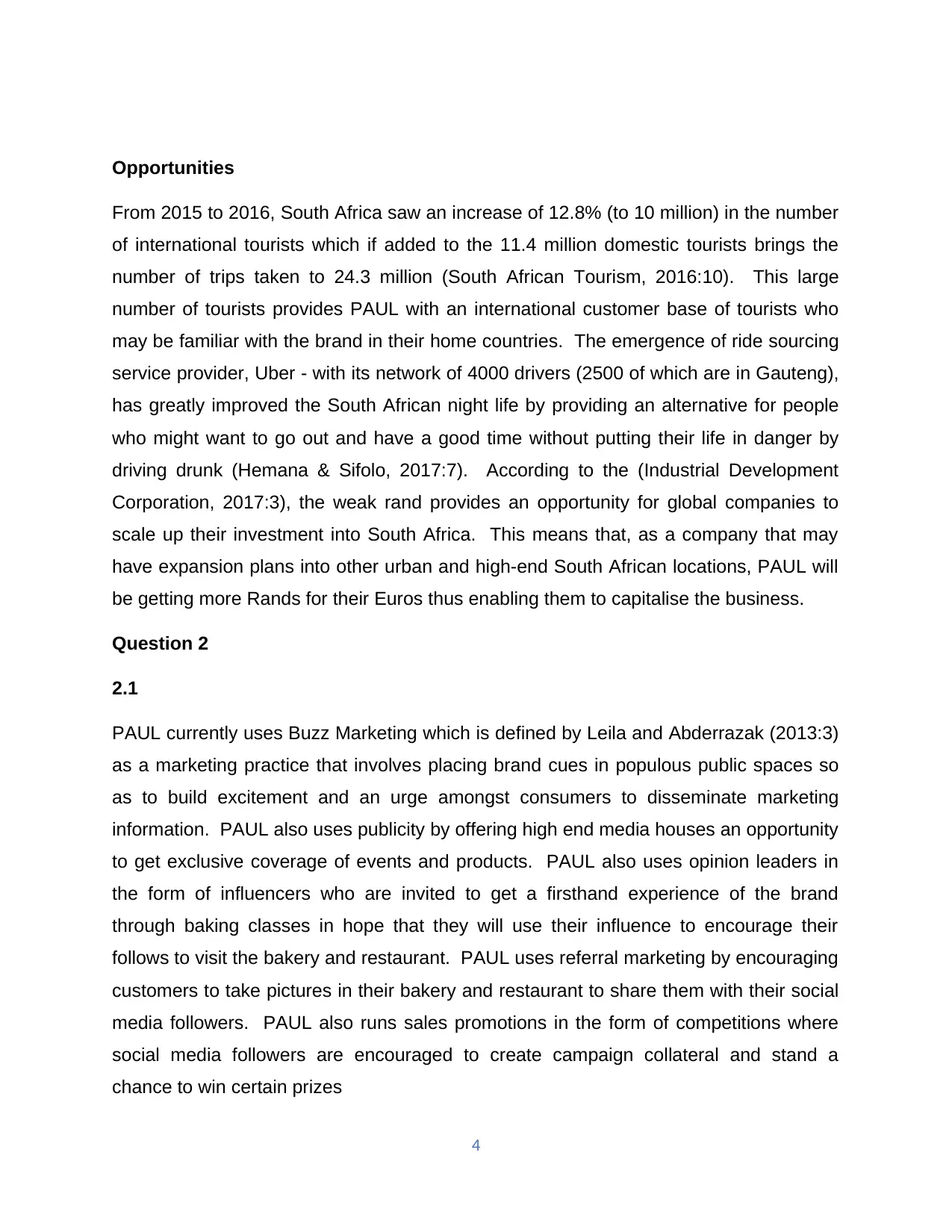
Opportunities
From 2015 to 2016, South Africa saw an increase of 12.8% (to 10 million) in the number
of international tourists which if added to the 11.4 million domestic tourists brings the
number of trips taken to 24.3 million (South African Tourism, 2016:10). This large
number of tourists provides PAUL with an international customer base of tourists who
may be familiar with the brand in their home countries. The emergence of ride sourcing
service provider, Uber - with its network of 4000 drivers (2500 of which are in Gauteng),
has greatly improved the South African night life by providing an alternative for people
who might want to go out and have a good time without putting their life in danger by
driving drunk (Hemana & Sifolo, 2017:7). According to the (Industrial Development
Corporation, 2017:3), the weak rand provides an opportunity for global companies to
scale up their investment into South Africa. This means that, as a company that may
have expansion plans into other urban and high-end South African locations, PAUL will
be getting more Rands for their Euros thus enabling them to capitalise the business.
Question 2
2.1
PAUL currently uses Buzz Marketing which is defined by Leila and Abderrazak (2013:3)
as a marketing practice that involves placing brand cues in populous public spaces so
as to build excitement and an urge amongst consumers to disseminate marketing
information. PAUL also uses publicity by offering high end media houses an opportunity
to get exclusive coverage of events and products. PAUL also uses opinion leaders in
the form of influencers who are invited to get a firsthand experience of the brand
through baking classes in hope that they will use their influence to encourage their
follows to visit the bakery and restaurant. PAUL uses referral marketing by encouraging
customers to take pictures in their bakery and restaurant to share them with their social
media followers. PAUL also runs sales promotions in the form of competitions where
social media followers are encouraged to create campaign collateral and stand a
chance to win certain prizes
4
From 2015 to 2016, South Africa saw an increase of 12.8% (to 10 million) in the number
of international tourists which if added to the 11.4 million domestic tourists brings the
number of trips taken to 24.3 million (South African Tourism, 2016:10). This large
number of tourists provides PAUL with an international customer base of tourists who
may be familiar with the brand in their home countries. The emergence of ride sourcing
service provider, Uber - with its network of 4000 drivers (2500 of which are in Gauteng),
has greatly improved the South African night life by providing an alternative for people
who might want to go out and have a good time without putting their life in danger by
driving drunk (Hemana & Sifolo, 2017:7). According to the (Industrial Development
Corporation, 2017:3), the weak rand provides an opportunity for global companies to
scale up their investment into South Africa. This means that, as a company that may
have expansion plans into other urban and high-end South African locations, PAUL will
be getting more Rands for their Euros thus enabling them to capitalise the business.
Question 2
2.1
PAUL currently uses Buzz Marketing which is defined by Leila and Abderrazak (2013:3)
as a marketing practice that involves placing brand cues in populous public spaces so
as to build excitement and an urge amongst consumers to disseminate marketing
information. PAUL also uses publicity by offering high end media houses an opportunity
to get exclusive coverage of events and products. PAUL also uses opinion leaders in
the form of influencers who are invited to get a firsthand experience of the brand
through baking classes in hope that they will use their influence to encourage their
follows to visit the bakery and restaurant. PAUL uses referral marketing by encouraging
customers to take pictures in their bakery and restaurant to share them with their social
media followers. PAUL also runs sales promotions in the form of competitions where
social media followers are encouraged to create campaign collateral and stand a
chance to win certain prizes
4
Paraphrase This Document
Need a fresh take? Get an instant paraphrase of this document with our AI Paraphraser
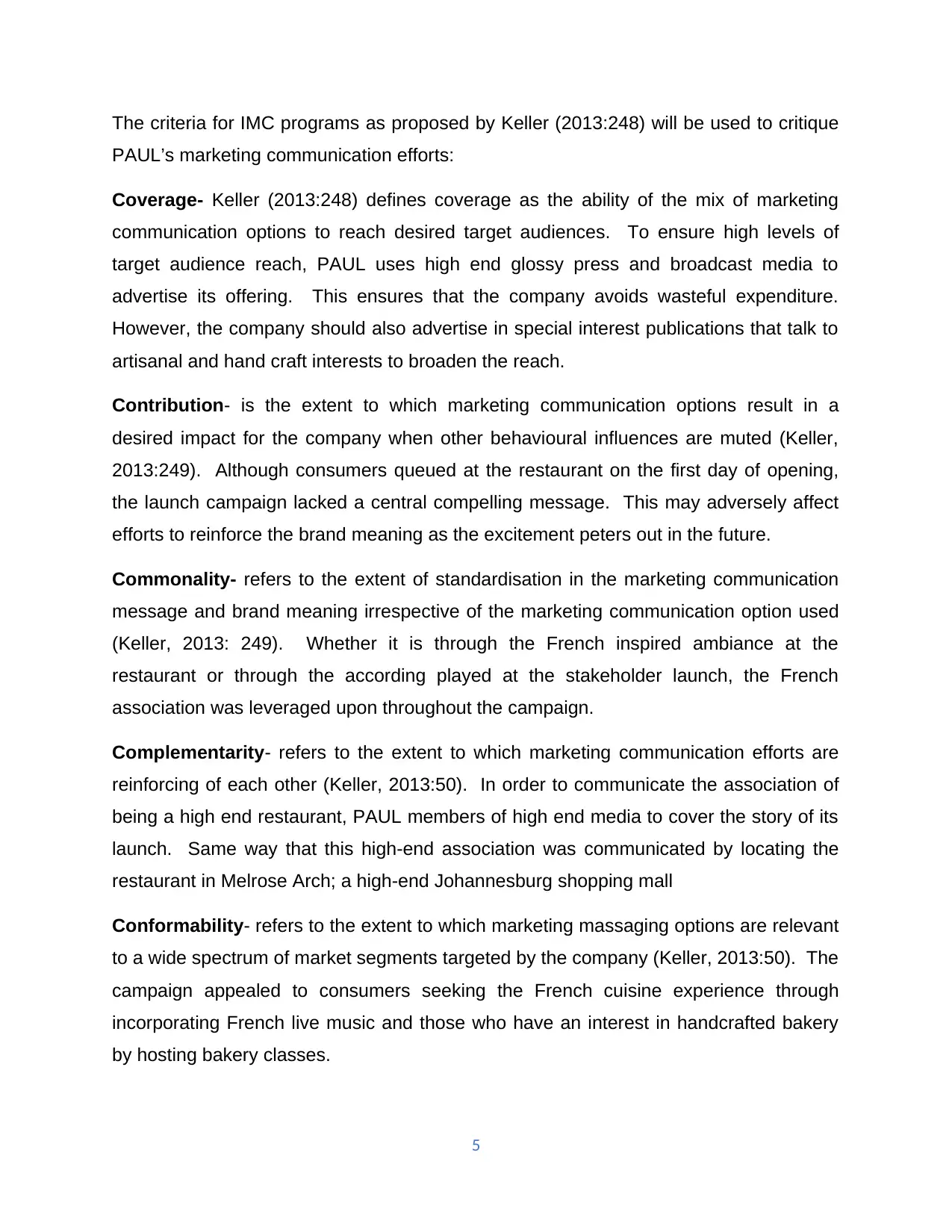
The criteria for IMC programs as proposed by Keller (2013:248) will be used to critique
PAUL’s marketing communication efforts:
Coverage- Keller (2013:248) defines coverage as the ability of the mix of marketing
communication options to reach desired target audiences. To ensure high levels of
target audience reach, PAUL uses high end glossy press and broadcast media to
advertise its offering. This ensures that the company avoids wasteful expenditure.
However, the company should also advertise in special interest publications that talk to
artisanal and hand craft interests to broaden the reach.
Contribution- is the extent to which marketing communication options result in a
desired impact for the company when other behavioural influences are muted (Keller,
2013:249). Although consumers queued at the restaurant on the first day of opening,
the launch campaign lacked a central compelling message. This may adversely affect
efforts to reinforce the brand meaning as the excitement peters out in the future.
Commonality- refers to the extent of standardisation in the marketing communication
message and brand meaning irrespective of the marketing communication option used
(Keller, 2013: 249). Whether it is through the French inspired ambiance at the
restaurant or through the according played at the stakeholder launch, the French
association was leveraged upon throughout the campaign.
Complementarity- refers to the extent to which marketing communication efforts are
reinforcing of each other (Keller, 2013:50). In order to communicate the association of
being a high end restaurant, PAUL members of high end media to cover the story of its
launch. Same way that this high-end association was communicated by locating the
restaurant in Melrose Arch; a high-end Johannesburg shopping mall
Conformability- refers to the extent to which marketing massaging options are relevant
to a wide spectrum of market segments targeted by the company (Keller, 2013:50). The
campaign appealed to consumers seeking the French cuisine experience through
incorporating French live music and those who have an interest in handcrafted bakery
by hosting bakery classes.
5
PAUL’s marketing communication efforts:
Coverage- Keller (2013:248) defines coverage as the ability of the mix of marketing
communication options to reach desired target audiences. To ensure high levels of
target audience reach, PAUL uses high end glossy press and broadcast media to
advertise its offering. This ensures that the company avoids wasteful expenditure.
However, the company should also advertise in special interest publications that talk to
artisanal and hand craft interests to broaden the reach.
Contribution- is the extent to which marketing communication options result in a
desired impact for the company when other behavioural influences are muted (Keller,
2013:249). Although consumers queued at the restaurant on the first day of opening,
the launch campaign lacked a central compelling message. This may adversely affect
efforts to reinforce the brand meaning as the excitement peters out in the future.
Commonality- refers to the extent of standardisation in the marketing communication
message and brand meaning irrespective of the marketing communication option used
(Keller, 2013: 249). Whether it is through the French inspired ambiance at the
restaurant or through the according played at the stakeholder launch, the French
association was leveraged upon throughout the campaign.
Complementarity- refers to the extent to which marketing communication efforts are
reinforcing of each other (Keller, 2013:50). In order to communicate the association of
being a high end restaurant, PAUL members of high end media to cover the story of its
launch. Same way that this high-end association was communicated by locating the
restaurant in Melrose Arch; a high-end Johannesburg shopping mall
Conformability- refers to the extent to which marketing massaging options are relevant
to a wide spectrum of market segments targeted by the company (Keller, 2013:50). The
campaign appealed to consumers seeking the French cuisine experience through
incorporating French live music and those who have an interest in handcrafted bakery
by hosting bakery classes.
5
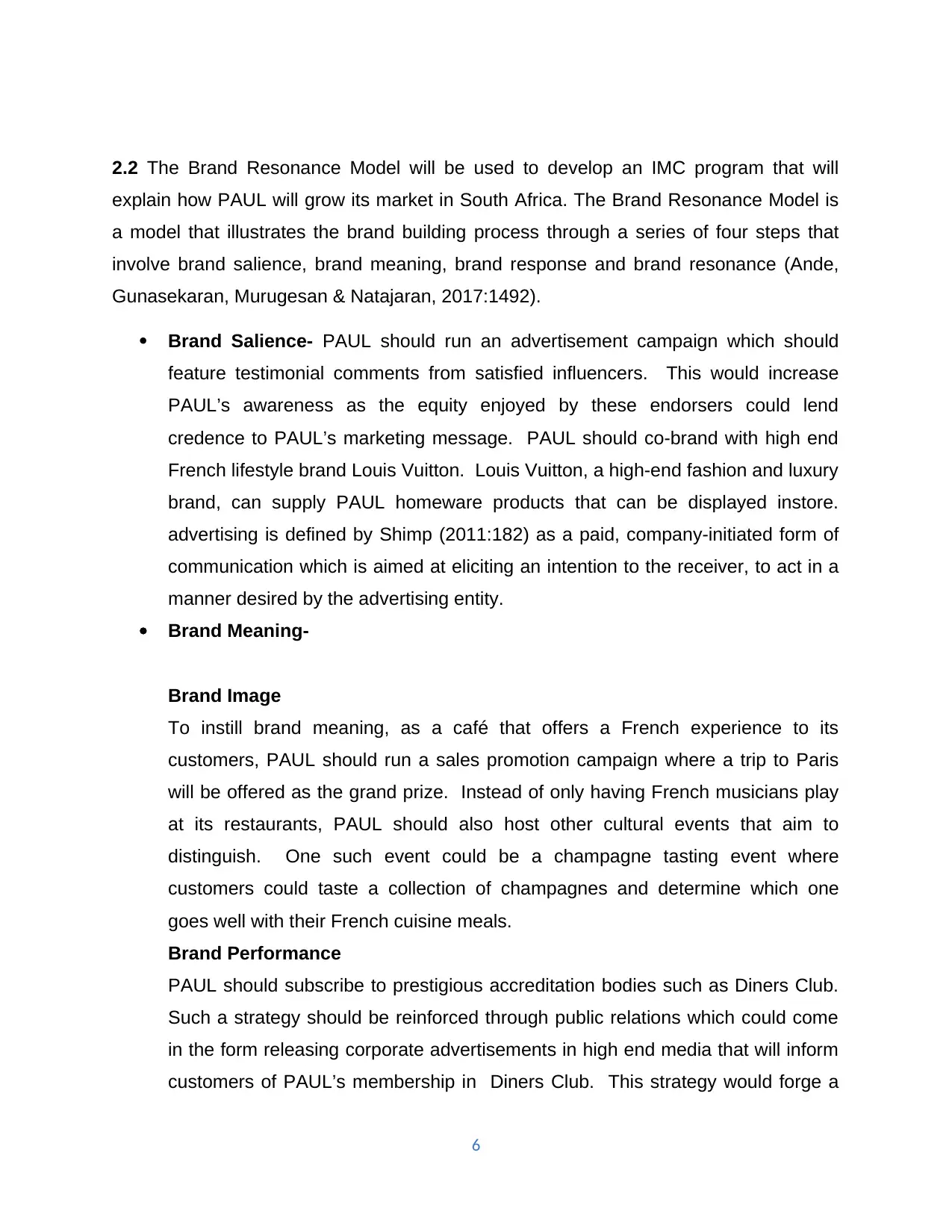
2.2 The Brand Resonance Model will be used to develop an IMC program that will
explain how PAUL will grow its market in South Africa. The Brand Resonance Model is
a model that illustrates the brand building process through a series of four steps that
involve brand salience, brand meaning, brand response and brand resonance (Ande,
Gunasekaran, Murugesan & Natajaran, 2017:1492).
Brand Salience- PAUL should run an advertisement campaign which should
feature testimonial comments from satisfied influencers. This would increase
PAUL’s awareness as the equity enjoyed by these endorsers could lend
credence to PAUL’s marketing message. PAUL should co-brand with high end
French lifestyle brand Louis Vuitton. Louis Vuitton, a high-end fashion and luxury
brand, can supply PAUL homeware products that can be displayed instore.
advertising is defined by Shimp (2011:182) as a paid, company-initiated form of
communication which is aimed at eliciting an intention to the receiver, to act in a
manner desired by the advertising entity.
Brand Meaning-
Brand Image
To instill brand meaning, as a café that offers a French experience to its
customers, PAUL should run a sales promotion campaign where a trip to Paris
will be offered as the grand prize. Instead of only having French musicians play
at its restaurants, PAUL should also host other cultural events that aim to
distinguish. One such event could be a champagne tasting event where
customers could taste a collection of champagnes and determine which one
goes well with their French cuisine meals.
Brand Performance
PAUL should subscribe to prestigious accreditation bodies such as Diners Club.
Such a strategy should be reinforced through public relations which could come
in the form releasing corporate advertisements in high end media that will inform
customers of PAUL’s membership in Diners Club. This strategy would forge a
6
explain how PAUL will grow its market in South Africa. The Brand Resonance Model is
a model that illustrates the brand building process through a series of four steps that
involve brand salience, brand meaning, brand response and brand resonance (Ande,
Gunasekaran, Murugesan & Natajaran, 2017:1492).
Brand Salience- PAUL should run an advertisement campaign which should
feature testimonial comments from satisfied influencers. This would increase
PAUL’s awareness as the equity enjoyed by these endorsers could lend
credence to PAUL’s marketing message. PAUL should co-brand with high end
French lifestyle brand Louis Vuitton. Louis Vuitton, a high-end fashion and luxury
brand, can supply PAUL homeware products that can be displayed instore.
advertising is defined by Shimp (2011:182) as a paid, company-initiated form of
communication which is aimed at eliciting an intention to the receiver, to act in a
manner desired by the advertising entity.
Brand Meaning-
Brand Image
To instill brand meaning, as a café that offers a French experience to its
customers, PAUL should run a sales promotion campaign where a trip to Paris
will be offered as the grand prize. Instead of only having French musicians play
at its restaurants, PAUL should also host other cultural events that aim to
distinguish. One such event could be a champagne tasting event where
customers could taste a collection of champagnes and determine which one
goes well with their French cuisine meals.
Brand Performance
PAUL should subscribe to prestigious accreditation bodies such as Diners Club.
Such a strategy should be reinforced through public relations which could come
in the form releasing corporate advertisements in high end media that will inform
customers of PAUL’s membership in Diners Club. This strategy would forge a
6
⊘ This is a preview!⊘
Do you want full access?
Subscribe today to unlock all pages.

Trusted by 1+ million students worldwide
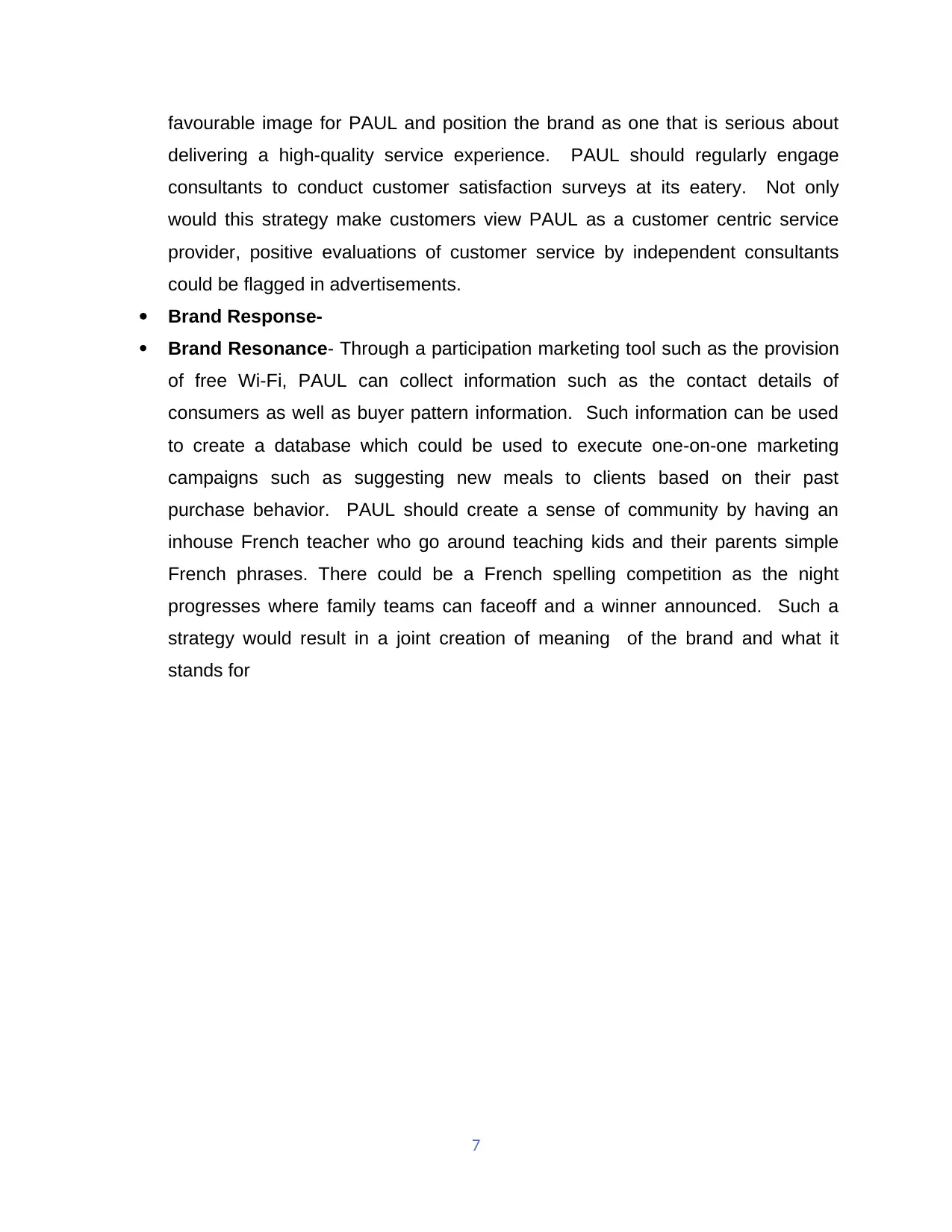
favourable image for PAUL and position the brand as one that is serious about
delivering a high-quality service experience. PAUL should regularly engage
consultants to conduct customer satisfaction surveys at its eatery. Not only
would this strategy make customers view PAUL as a customer centric service
provider, positive evaluations of customer service by independent consultants
could be flagged in advertisements.
Brand Response-
Brand Resonance- Through a participation marketing tool such as the provision
of free Wi-Fi, PAUL can collect information such as the contact details of
consumers as well as buyer pattern information. Such information can be used
to create a database which could be used to execute one-on-one marketing
campaigns such as suggesting new meals to clients based on their past
purchase behavior. PAUL should create a sense of community by having an
inhouse French teacher who go around teaching kids and their parents simple
French phrases. There could be a French spelling competition as the night
progresses where family teams can faceoff and a winner announced. Such a
strategy would result in a joint creation of meaning of the brand and what it
stands for
7
delivering a high-quality service experience. PAUL should regularly engage
consultants to conduct customer satisfaction surveys at its eatery. Not only
would this strategy make customers view PAUL as a customer centric service
provider, positive evaluations of customer service by independent consultants
could be flagged in advertisements.
Brand Response-
Brand Resonance- Through a participation marketing tool such as the provision
of free Wi-Fi, PAUL can collect information such as the contact details of
consumers as well as buyer pattern information. Such information can be used
to create a database which could be used to execute one-on-one marketing
campaigns such as suggesting new meals to clients based on their past
purchase behavior. PAUL should create a sense of community by having an
inhouse French teacher who go around teaching kids and their parents simple
French phrases. There could be a French spelling competition as the night
progresses where family teams can faceoff and a winner announced. Such a
strategy would result in a joint creation of meaning of the brand and what it
stands for
7
Paraphrase This Document
Need a fresh take? Get an instant paraphrase of this document with our AI Paraphraser
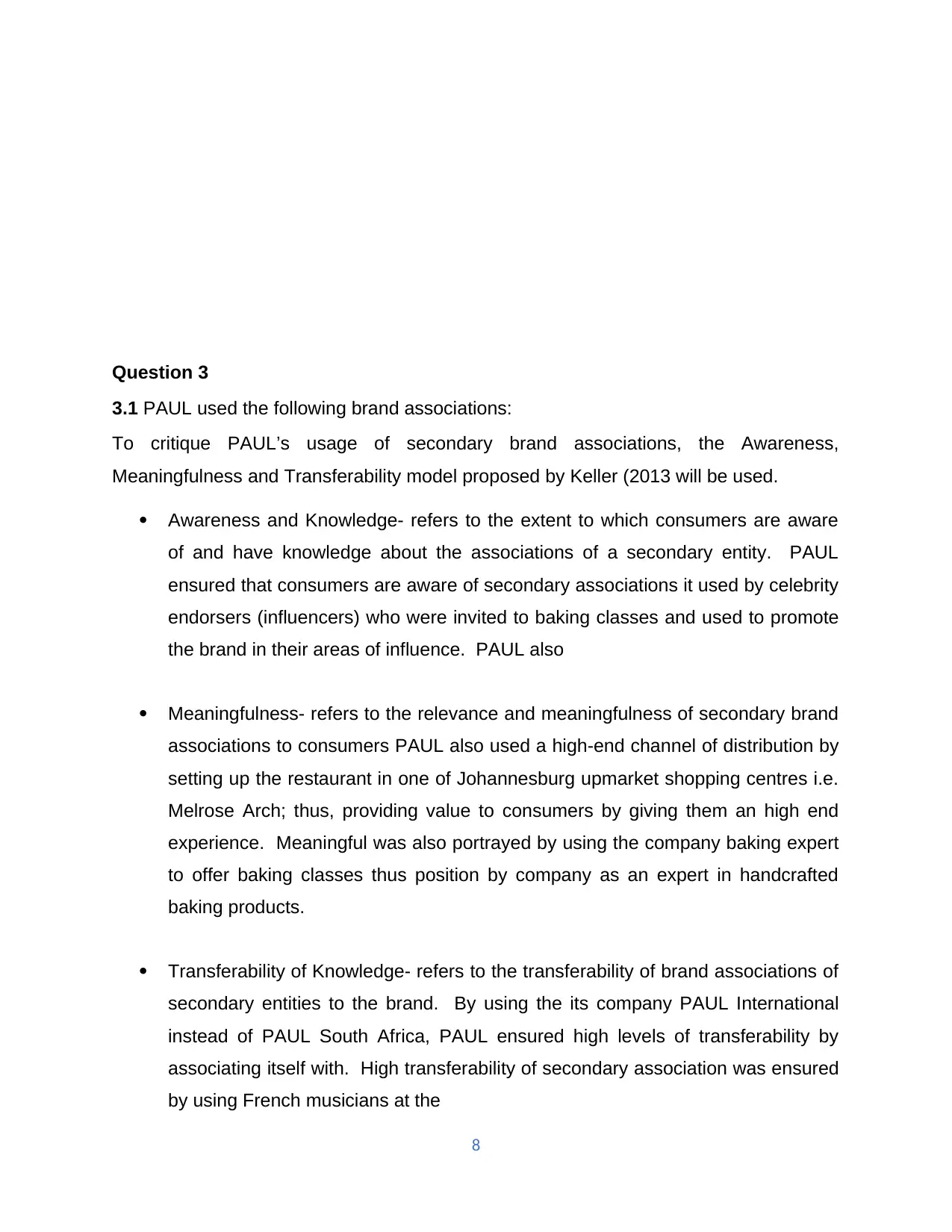
Question 3
3.1 PAUL used the following brand associations:
To critique PAUL’s usage of secondary brand associations, the Awareness,
Meaningfulness and Transferability model proposed by Keller (2013 will be used.
Awareness and Knowledge- refers to the extent to which consumers are aware
of and have knowledge about the associations of a secondary entity. PAUL
ensured that consumers are aware of secondary associations it used by celebrity
endorsers (influencers) who were invited to baking classes and used to promote
the brand in their areas of influence. PAUL also
Meaningfulness- refers to the relevance and meaningfulness of secondary brand
associations to consumers PAUL also used a high-end channel of distribution by
setting up the restaurant in one of Johannesburg upmarket shopping centres i.e.
Melrose Arch; thus, providing value to consumers by giving them an high end
experience. Meaningful was also portrayed by using the company baking expert
to offer baking classes thus position by company as an expert in handcrafted
baking products.
Transferability of Knowledge- refers to the transferability of brand associations of
secondary entities to the brand. By using the its company PAUL International
instead of PAUL South Africa, PAUL ensured high levels of transferability by
associating itself with. High transferability of secondary association was ensured
by using French musicians at the
8
3.1 PAUL used the following brand associations:
To critique PAUL’s usage of secondary brand associations, the Awareness,
Meaningfulness and Transferability model proposed by Keller (2013 will be used.
Awareness and Knowledge- refers to the extent to which consumers are aware
of and have knowledge about the associations of a secondary entity. PAUL
ensured that consumers are aware of secondary associations it used by celebrity
endorsers (influencers) who were invited to baking classes and used to promote
the brand in their areas of influence. PAUL also
Meaningfulness- refers to the relevance and meaningfulness of secondary brand
associations to consumers PAUL also used a high-end channel of distribution by
setting up the restaurant in one of Johannesburg upmarket shopping centres i.e.
Melrose Arch; thus, providing value to consumers by giving them an high end
experience. Meaningful was also portrayed by using the company baking expert
to offer baking classes thus position by company as an expert in handcrafted
baking products.
Transferability of Knowledge- refers to the transferability of brand associations of
secondary entities to the brand. By using the its company PAUL International
instead of PAUL South Africa, PAUL ensured high levels of transferability by
associating itself with. High transferability of secondary association was ensured
by using French musicians at the
8
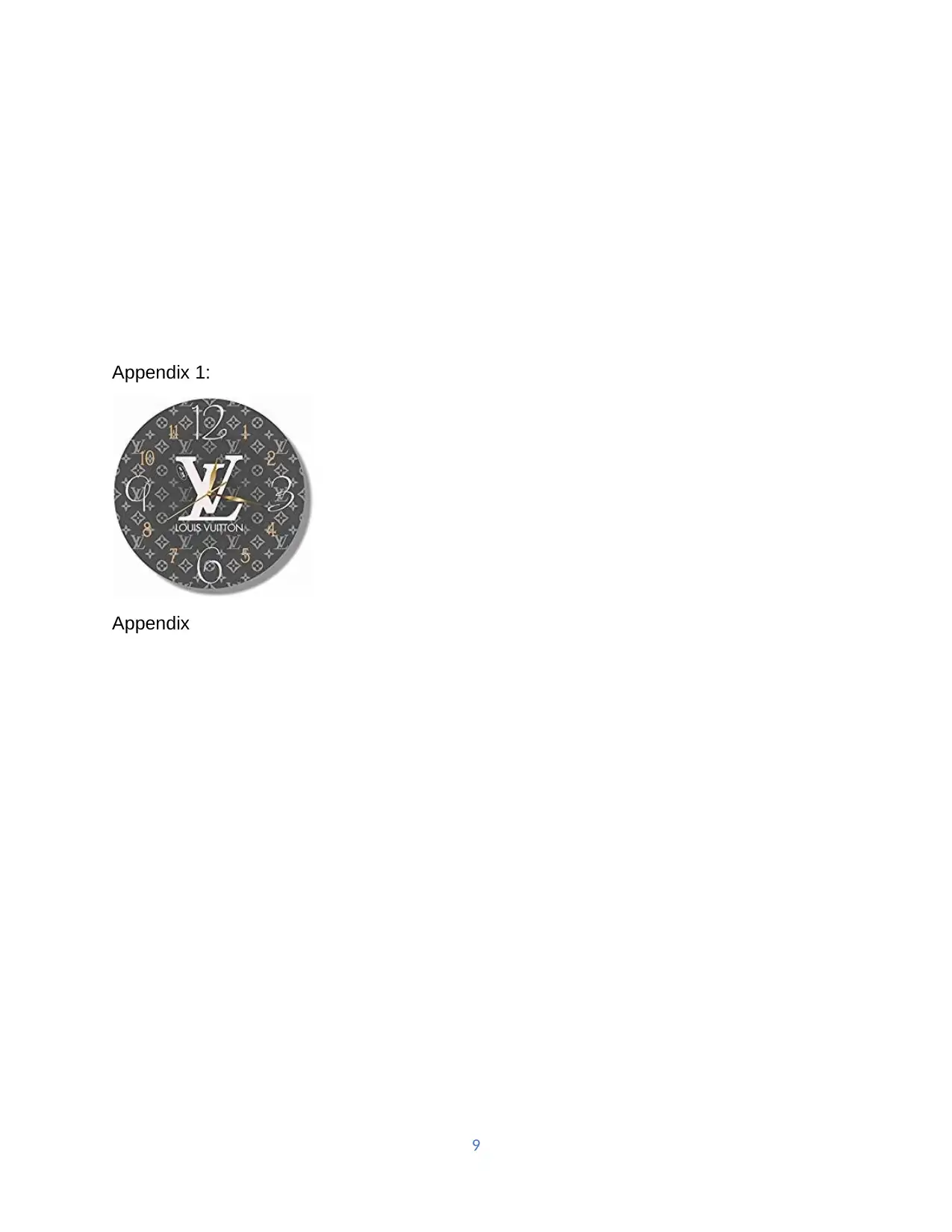
Appendix 1:
Appendix
9
Appendix
9
⊘ This is a preview!⊘
Do you want full access?
Subscribe today to unlock all pages.

Trusted by 1+ million students worldwide
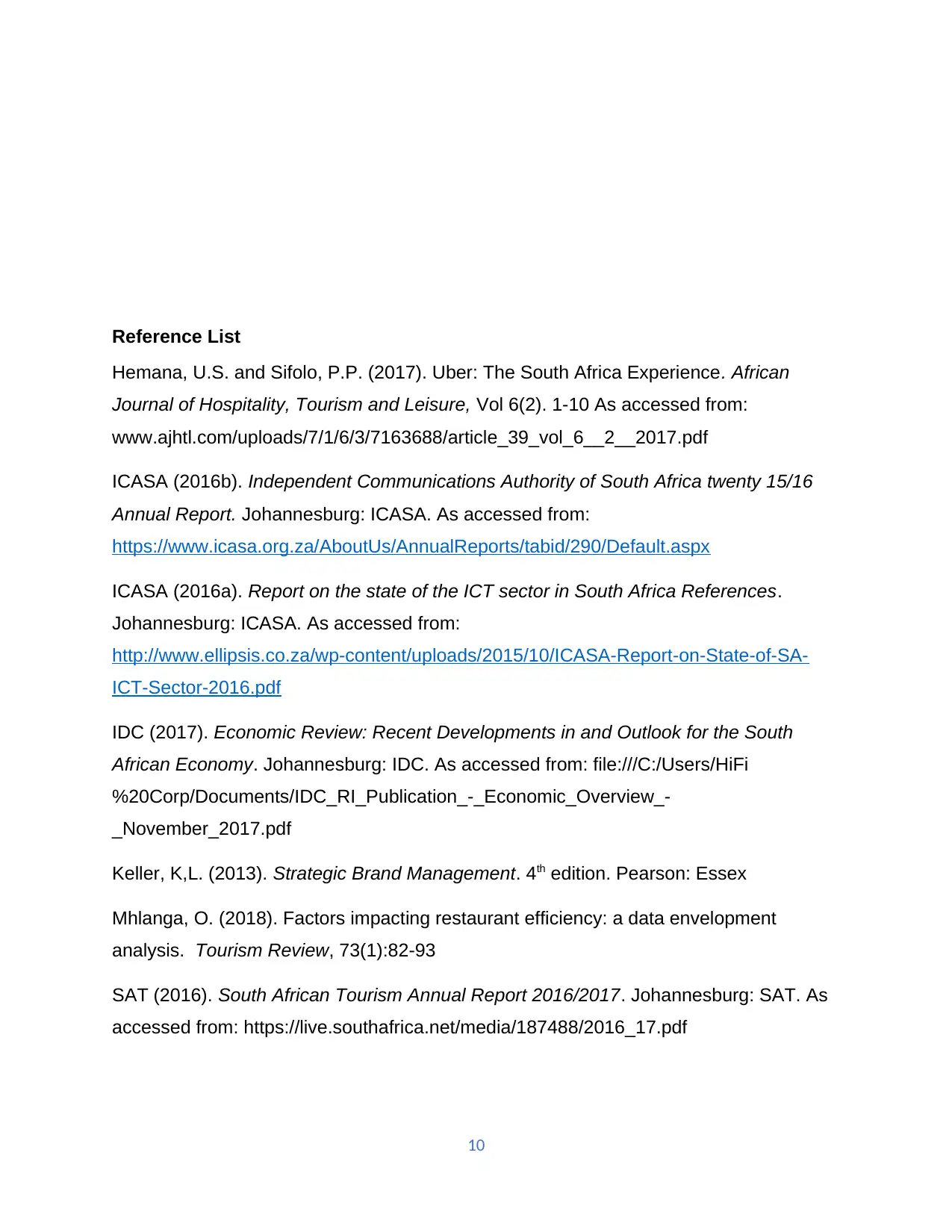
Reference List
Hemana, U.S. and Sifolo, P.P. (2017). Uber: The South Africa Experience. African
Journal of Hospitality, Tourism and Leisure, Vol 6(2). 1-10 As accessed from:
www.ajhtl.com/uploads/7/1/6/3/7163688/article_39_vol_6__2__2017.pdf
ICASA (2016b). Independent Communications Authority of South Africa twenty 15/16
Annual Report. Johannesburg: ICASA. As accessed from:
https://www.icasa.org.za/AboutUs/AnnualReports/tabid/290/Default.aspx
ICASA (2016a). Report on the state of the ICT sector in South Africa References.
Johannesburg: ICASA. As accessed from:
http://www.ellipsis.co.za/wp-content/uploads/2015/10/ICASA-Report-on-State-of-SA-
ICT-Sector-2016.pdf
IDC (2017). Economic Review: Recent Developments in and Outlook for the South
African Economy. Johannesburg: IDC. As accessed from: file:///C:/Users/HiFi
%20Corp/Documents/IDC_RI_Publication_-_Economic_Overview_-
_November_2017.pdf
Keller, K,L. (2013). Strategic Brand Management. 4th edition. Pearson: Essex
Mhlanga, O. (2018). Factors impacting restaurant efficiency: a data envelopment
analysis. Tourism Review, 73(1):82-93
SAT (2016). South African Tourism Annual Report 2016/2017. Johannesburg: SAT. As
accessed from: https://live.southafrica.net/media/187488/2016_17.pdf
10
Hemana, U.S. and Sifolo, P.P. (2017). Uber: The South Africa Experience. African
Journal of Hospitality, Tourism and Leisure, Vol 6(2). 1-10 As accessed from:
www.ajhtl.com/uploads/7/1/6/3/7163688/article_39_vol_6__2__2017.pdf
ICASA (2016b). Independent Communications Authority of South Africa twenty 15/16
Annual Report. Johannesburg: ICASA. As accessed from:
https://www.icasa.org.za/AboutUs/AnnualReports/tabid/290/Default.aspx
ICASA (2016a). Report on the state of the ICT sector in South Africa References.
Johannesburg: ICASA. As accessed from:
http://www.ellipsis.co.za/wp-content/uploads/2015/10/ICASA-Report-on-State-of-SA-
ICT-Sector-2016.pdf
IDC (2017). Economic Review: Recent Developments in and Outlook for the South
African Economy. Johannesburg: IDC. As accessed from: file:///C:/Users/HiFi
%20Corp/Documents/IDC_RI_Publication_-_Economic_Overview_-
_November_2017.pdf
Keller, K,L. (2013). Strategic Brand Management. 4th edition. Pearson: Essex
Mhlanga, O. (2018). Factors impacting restaurant efficiency: a data envelopment
analysis. Tourism Review, 73(1):82-93
SAT (2016). South African Tourism Annual Report 2016/2017. Johannesburg: SAT. As
accessed from: https://live.southafrica.net/media/187488/2016_17.pdf
10
Paraphrase This Document
Need a fresh take? Get an instant paraphrase of this document with our AI Paraphraser
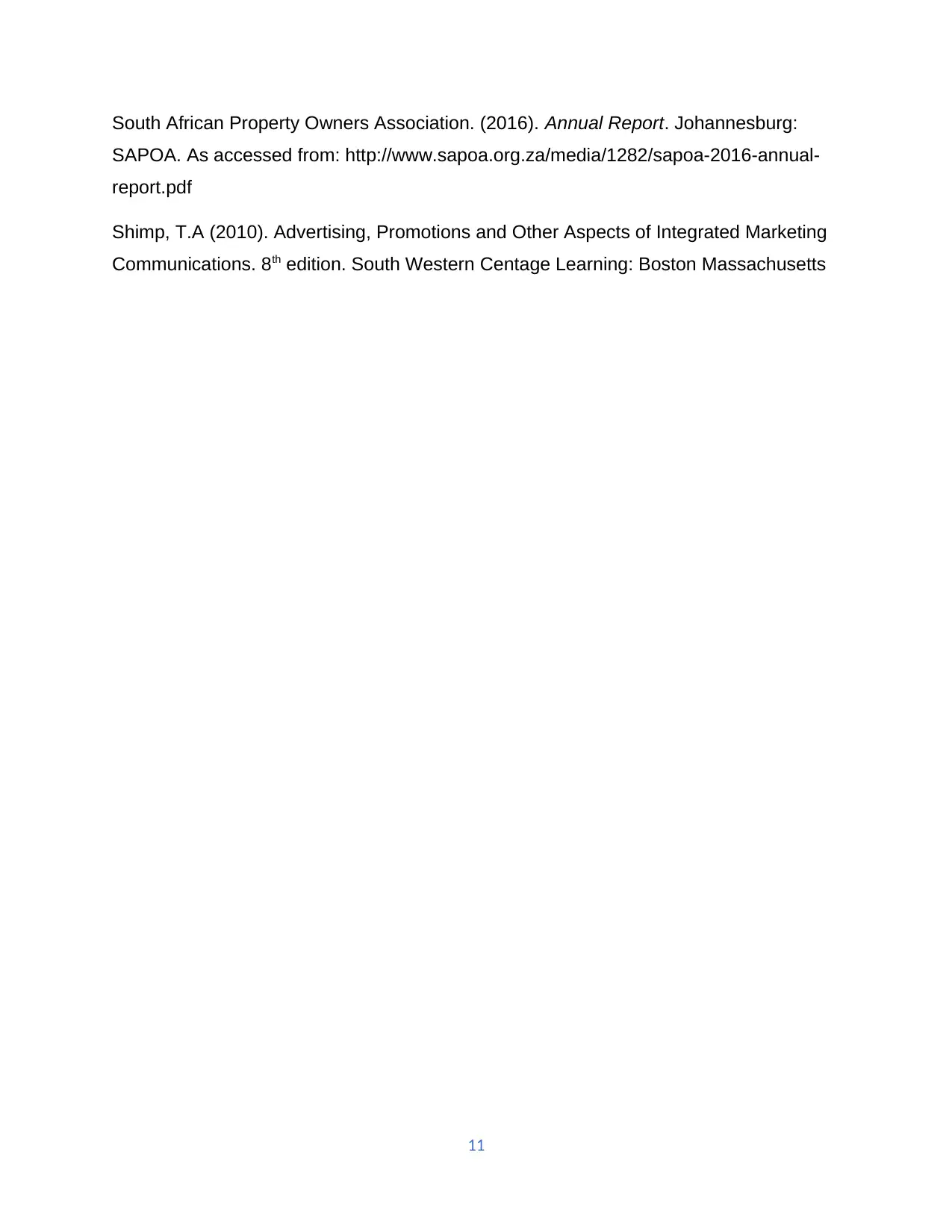
South African Property Owners Association. (2016). Annual Report. Johannesburg:
SAPOA. As accessed from: http://www.sapoa.org.za/media/1282/sapoa-2016-annual-
report.pdf
Shimp, T.A (2010). Advertising, Promotions and Other Aspects of Integrated Marketing
Communications. 8th edition. South Western Centage Learning: Boston Massachusetts
11
SAPOA. As accessed from: http://www.sapoa.org.za/media/1282/sapoa-2016-annual-
report.pdf
Shimp, T.A (2010). Advertising, Promotions and Other Aspects of Integrated Marketing
Communications. 8th edition. South Western Centage Learning: Boston Massachusetts
11
1 out of 11
Related Documents
Your All-in-One AI-Powered Toolkit for Academic Success.
+13062052269
info@desklib.com
Available 24*7 on WhatsApp / Email
![[object Object]](/_next/static/media/star-bottom.7253800d.svg)
Unlock your academic potential
Copyright © 2020–2025 A2Z Services. All Rights Reserved. Developed and managed by ZUCOL.




